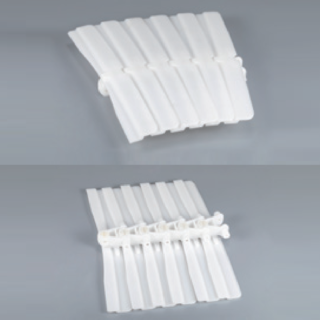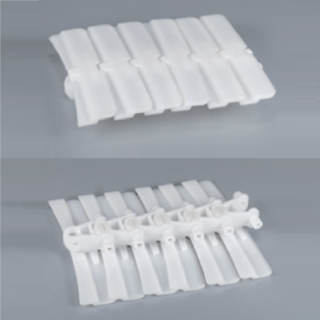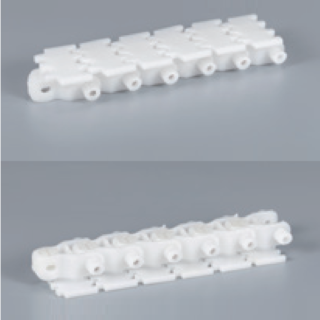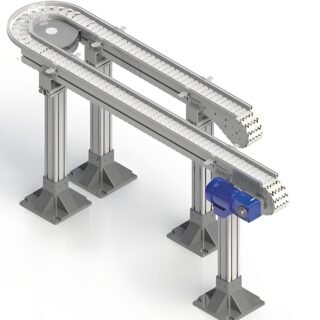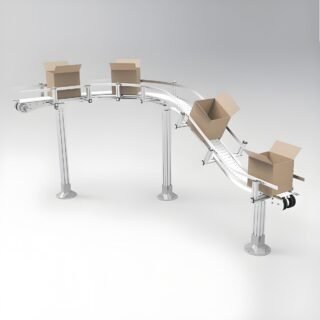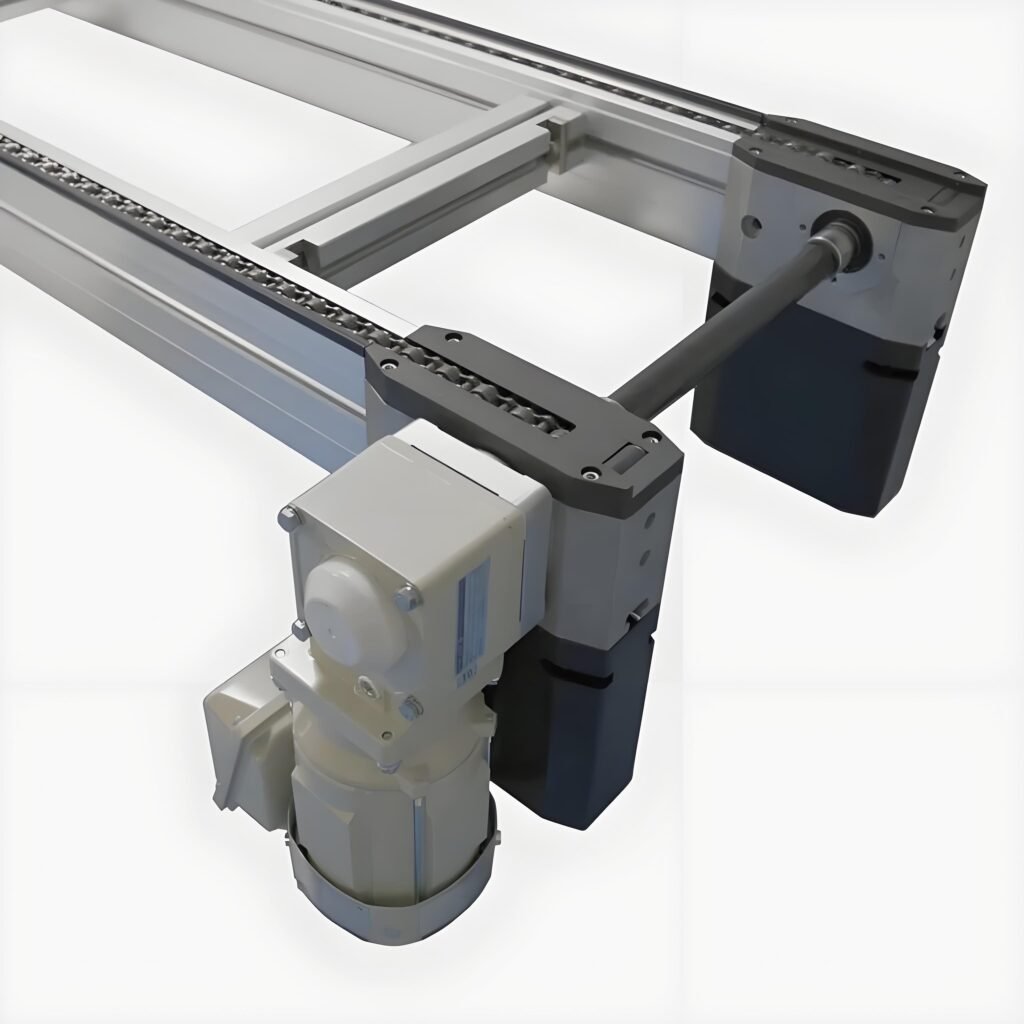As automated manufacturing continues to expand worldwide, factories are upgrading their material-handling systems to achieve higher efficiency, better flexibility, and lower operational costs. Among all conveyor technologies, flexible chain conveyors (also called modular chain conveyors) have quickly become one of the most widely adopted solutions in automated production lines.
Why are so many factories transitioning to flexible chain conveyors?
What advantages do they offer compared to conventional belt conveyors, roller conveyors, or pallet conveyors?
In this in-depth guide, we break down the top 5 reasons automated factories rely on flexible chain conveyor systems—and how they help manufacturers boost productivity, reduce downtime, and optimize factory layouts.
-
 Chaîne flexible en acier inoxydable
Chaîne flexible en acier inoxydable -
 Chaîne flexible de 295 mm de large
Chaîne flexible de 295 mm de large -
 Chaîne flexible de 175 mm de largeur
Chaîne flexible de 175 mm de largeur -
 Chaîne flexible de 83 mm de largeur
Chaîne flexible de 83 mm de largeur -
 Chaîne flexible de 63 mm de largeur
Chaîne flexible de 63 mm de largeur -
 Chaîne flexible de 43 mm de largeur
Chaîne flexible de 43 mm de largeur -
 Convoyeur à chaîne flexible Vitrans
Convoyeur à chaîne flexible Vitrans -
 Vitrans Flexible Chain Conveyor | Flexible Pallet Conveyor
Vitrans Flexible Chain Conveyor | Flexible Pallet Conveyor -
 Vitrans Flexible Chain Conveyor | Sliding Conveyor System
Vitrans Flexible Chain Conveyor | Sliding Conveyor System
What Is a Flexible Chain Conveyor?
A convoyeur à chaîne flexible uses interlocking plastic or steel chain modules to transport products through straight lines, curves, inclines, declines, and multi-level layouts. Unlike traditional belt systems, these conveyors are designed to be modular, easy to reconfigure, and capable of running smoothly in complex pathways.
Key characteristics include:
- Modular chain links that can be replaced individually
- Ability to integrate curves, S-curves, inclines, and declines
- Strong, stable product handling
- Smooth, low-friction movement
- Fast installation and reconfiguration
This design makes them ideal for automated production environments that require speed, precision, and adaptability.
5 Key Reasons Automated Factories Are Using Flexible Chain Conveyors
1. Exceptional Modularity and Easy Scalability
Modern factories rarely stay the same for long. Products evolve, workflows change, and production layouts must adapt. Flexible chain conveyors excel in environments where constant improvement and line reconfiguration are required.
Why Modularity Matters
- Add or remove curves and straight sections easily
- Fast layout changes when new machines or robots are installed
- Lower installation cost and higher reusability
- Ideal for phased factory expansion
Real-world example: an electronics assembly line reconfigures stations within hours instead of days by adjusting only chain segments instead of replacing large belts.
2. Significant Energy Savings and Long-Term Cost Reduction
Flexible chain conveyors are efficacité énergétique due to low-friction chain design.
Energy-Saving Benefits
- Lower electricity consumption
- Reduced mechanical stress on motors
- Less heat generation and longer equipment lifespan
- Lower long-term operating cost
For factories running 24/7, these savings accumulate quickly.
3. High Throughput, Smooth Transport, and Excellent Speed Control
Flexible chain conveyors maintain stable product handling even at high speeds or complex layouts.
Performance Benefits
- Smooth acceleration and deceleration
- Ideal for robotics, vision systems, and inspection lines
- Supports high throughput with precision
- Reduced vibration — protects fragile products
They are widely used in electronics, packaging, food, logistics, and precision manufacturing.
4. Low Maintenance, Long Service Life, and Easy Repairs
Traditional belt conveyors require frequent tensioning and replacement. Flexible chain conveyors reduce maintenance dramatically.
Maintenance Advantages
- Replace only damaged chain links
- Less downtime
- Easy cleaning and low lubrication needs
- Resistant to chemicals, wear, and industrial environments
Downtime is costly — modular chain links help factories maintain continuous operation.
5. Maximum Space Optimization for Modern Factory Layouts
Space is expensive. Flexible chain conveyors enable compact, efficient layouts.
Space-Saving Benefits
- Tight curves and vertical routing
- Multi-level conveyor flow
- Reduced footprint compared to belts or rollers
- Better operator access and safety
Example: a beverage plant reduced layout size by 30% using flexible chain conveyors with vertical lift transitions.

✅ Conveyor Comparison: Flexible Chain vs. Traditional Conveyor Systems
(
The table below summarizes how flexible chain conveyors compare with other common conveyor types in automated factories:
Conveyor Type Comparison Table
| Feature / Capability | Convoyeur à chaîne flexible | Convoyeur à bande | Convoyeur à rouleaux | Convoyeur de palettes |
|---|---|---|---|---|
| Modularity & Reconfiguration | ⭐ Excellent — modular links allow fast layout changes | ❌ Poor — belt replacement causes downtime | ⚠️ Limited — curves are large/expensive | ❌ Very limited |
| Efficacité spatiale | ⭐ Haut — tight curves & multi-level routing | ⚠️ Moderate | ❌ Low | ❌ Very low |
| Maintenance Cost | ⭐ Low — replace single chain links | ⚠️ Medium | ⚠️ Medium | ❌ High |
| Energy Consumption | ⭐ Low — low friction design | ⚠️ Moderate | ⚠️ Moderate–High | ❌ High |
| Compatibilité de l'automatisation | ⭐ Excellent | ⚠️ Moderate | ⚠️ Limited | ⚠️ Limited |
| Throughput Capability | ⭐ Haut | ⭐ High | ⚠️ Medium | ❌ Low–Medium |
| Curves & Multi-Direction | ⭐ Excellent | ❌ No | ⚠️ Limited | ❌ No |
| Product Stability | ⭐ Haut | ⚠️ Moderate | ⚠️ Varies | ⭐ High |
| Meilleur pour | Automated factories, packaging, electronics | Straight movement | Sorting & warehouses | Heavy-duty transport |
📌 Summary of the Comparison
Flexible chain conveyors clearly outperform traditional conveyor systems in modularity, automation compatibility, space-saving design, and long-term maintenance. While belt or roller conveyors still have their use in simple transport tasks, flexible chain systems are the preferred option for advanced automated production lines that require precision and scalability.
How to Choose the Right Flexible Chain Conveyor
Before selecting a system, consider the following:
- Product size, weight, and fragility
- Required throughput and speed
- Available floor space & layout complexity
- Inclines, declines, or curve requirements
- Operating environment
- Future expansion plans
- Supplier engineering capability
A good conveyor supplier should be able to provide layout simulation, customization options, and fast maintenance support.
Industries That Benefit Most From Flexible Chain Conveyors
- Électronique
- Packaging & labeling
- Food & beverage
- Logistics & warehousing
- Consumer goods
- Medical & pharmaceutical
- Automotive parts
These industries require precision, flexible layouts, and high throughput — the strengths of flexible chain conveyors.
Conclusion: Flexible Chain Conveyors Are the Future of Automated Manufacturing
As factories move toward higher levels of automation, flexible chain conveyors offer unmatched advantages:
- ✔️ Modularity
- ✔️ Energy efficiency
- ✔️ High throughput
- ✔️ Low maintenance
- ✔️ Optimized space usage
For manufacturers seeking to modernize their production lines, flexible chain conveyors deliver long-term performance and cost benefits.



